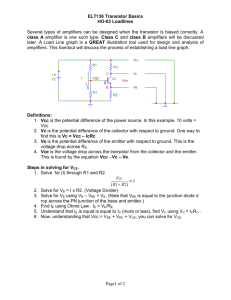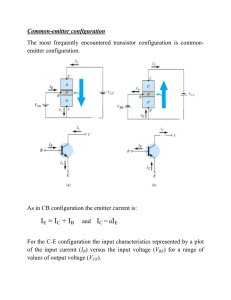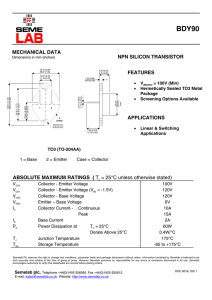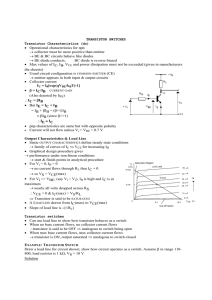ELECTRONICS I
advertisement
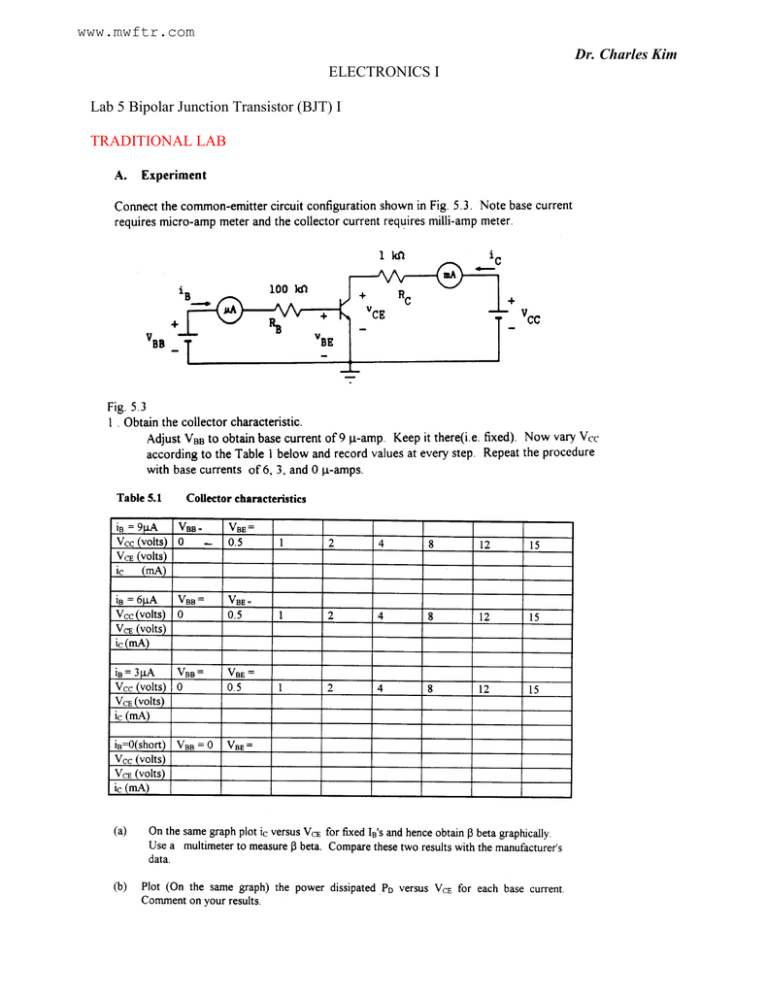
www.mwftr.com Dr. Charles Kim ELECTRONICS I Lab 5 Bipolar Junction Transistor (BJT) I TRADITIONAL LAB Dr. Charles Kim Dr. Charles Kim MOBILE STUDIO LAB Before We Start A transistor is a 3-terminal device available in two configurations, NPN and PNP. The transistor is one of the most important examples of an active component (Op Amp is another important active device as you already know) which amplifies and produces an output signal with more power than input signal. Of course, the additional power comes from the external power source we have to provide to the component. The most common, at least at the lab, NPN transistor is 2N2222. And there are two poplar types of packaging the transistor: TO-92 and TO-18. The properties of NPN transistors meet the following rules1: Rule 1: The Collector must be more positive than the Emitter. Rule 2: The Base-Emitter and Base-Collector circuits behave like diodes. Rule 3: There are maximum values of Collector current (IC), Base current(IB), Collector-Emitter voltage (VCE), Base-Emitter voltage (VBE) that cannot be exceeded. Rule 4 (Simple Rule): When rules 1-3 are obeyed, Collector current (IC) is roughly proportional to Base current (IB)and can be written as: IC=βIB , where β is the current gain, typically about 100. 1 Paul Horowitz and Winfield Hill, The Art of Electronics, Cambridge University Press, 1990. Dr. Charles Kim Point The Rule 4 says that a small current flowing into the Base controls a much larger current flowing into the Collector. The Rule 2 implies that an operating NPN transistor has VB=VE+VBE= VE+0.6 [V] relationship. 1. Experiment Overview In the lab manual this experiment has two components: 1. Collector current characteristics, and 2. Base characteristics. Specifically, the first one asks to connect IC and VCE with a given set of IBs. It again asks for connecting VCE and PD with the IBs, where PD, power dissipated, is given by PD=IBVBE+ ICVCE. On the other hand, the second one requires use to connect VBE and IB under different conditions of VCE. 2. Implementation of the circuit for Mobile Studio Lab As we discussed before, the current measurement in Mobile Studio Lab is performed by measuring voltage across the resistor through which the current is supposed to be measured. Also, the fixed voltage source from IOBoard must be fed via a variable resistor to provide variable voltage supply. So this is a sketch for the circuit implementation for the circuit. As you see in the above sketch, we connect +2.5V supply from the IOBoard to a variable resistor (left) for the current into the Base (B), and +5V supply from IOBoard to the other variable resistor for supplying into Collector (C). Emitter (E) is grounded. The Base current IB in [µA] into B is determined by multiplying the measured voltage across the 100K resistor in [V] by 10. On the other hand the Collector current IC in [mA] can be determined by the measured voltage across the 1K resistor. Dr. Charles Kim Implementation Example: The NPN transistor use is 2N2222 with TO-18 package type. Details of the circuit are shown below. Dr. Charles Kim 3. Collector Circuit Characteristics Experiment From the Table 5.1 and succeeding question, we see that there are numerous quantities to measure. And some voltage level is apparent that we cannot supply using the IOBoard. So I changed the Table 5.1 to accommodate the IOBoard and Mobile Studio Lab. Let's hope that the next version of IOBoard can handle any request from us and from manual. IB=9 µA VBE= IB=6 µA VBE= IB=3 µA VBE= IB=0 µA Collector Characteristics Table - IC vs VCE for different IBs. VCC [V] 0 0.5 1 2 3 4 0 0.5 1 VCC [V] 2 0 0.5 1 VCC [V] 2 3 4 5 1 VCC [V] 2 3 4 5 3 4 5 VCE IC VCE IC 0 VBE= 5 VCE IC 0.5 VCE IC It's apparent that, to fill the table, we have to measure 5 items: IB, VBE, VCC, VCE, and IC. Since we have only two channels in the scope function, we have to move our channel probes many different places in the breadboard. Here's my suggestion and sequence: 1. Use Channel 1 to measure IB (i.e., voltage across 100K resistor) while move the wiper of the left variable resistor, and keep it when IB is in the desired value. Don't change this for the entire measurement for a given IB value. 2. Use Channel 1 to measure VBE. 3. Now use Channel to measure VCC and we will not move this setting. We dedicate Channel 1 for VCC measurement. 4. Now move the wiper of the right variable resistor to have the desired value of VCC on Channel 1. 4.a. Use channel 2 to measure VCE. 4.b. Use channel 2 to measure IC (which is the voltage across 1K resistor) 5. Do the steps 1 - 4 for all four different IB values. 6. And draw a graph for IV vs. VCE for each of IB. 7. Can you find your β? Dr. Charles Kim The following photo is, after setting IB as 9µA, the measurement scheme for VCC (using Channel 1) and VCE (using Channel 2). Next come the Mobile Studio Desktop screen shot for the above measurement scheme. Dr. Charles Kim 4. Base Characteristics Experiment Since the 1K resistor now is shorted out and E is grounded, VCC is the same as VCE. Base Characteristics Table - IB vs VBE for different VCEs. VCE=4 V IB [uA] 0 1 2 3 6 9 VBE VCE=2 V 12 0 1 2 IB [uA] 3 6 9 12 0 1 2 IB [uA] 3 6 9 12 VBE VCE=0 V VBE Here we have 3 quantities to measure. We dedicate our channel 1 for IB measurement (i.e., voltage across 100k). Channel 2 will be used for both voltages: 1. Use and fix channel 1 to measure the Base current. 2. Use channel 2 to measure VCC (or VCE) by adjusting the right variable resistor and set the desired value. At the same time, set the value of IB by adjusting the left variable resistor for the desired value of IB. 3. Move the channel 2 to measure the voltage VBE. 4. Do the steps of 1-3 for other two values of VCE. 5. And draw a graph for VBE vs. IB for each of VCE. The photo below shows the measurement scheme for IB and VBE for IB = 6uA and VCE = 4V. In the photo above, channel 1 probes measure the voltage across 100K to indirectly measure the current into B, which is IB. Dr. Charles Kim Next shows the screen shot of the Mobile Studio Desktop of the scheme we use for Base characteristics. <Breadboard for above photo> 5. Part B- Statistical Analysis F'get about this! 6. PSpice Simulation a. Schematic Diagram for Collector Characteristics: Dr. Charles Kim b. Simulation for Current c. DC sweep analysis to find values while changing the voltage V2 from 0 to 15V * Set-up for DC Sweep Analysis Dr. Charles Kim * DC Sweep Setting d. Run for IC and VCE. Dr. Charles Kim e. Result 1 f. Result 2 - Details of IC.

